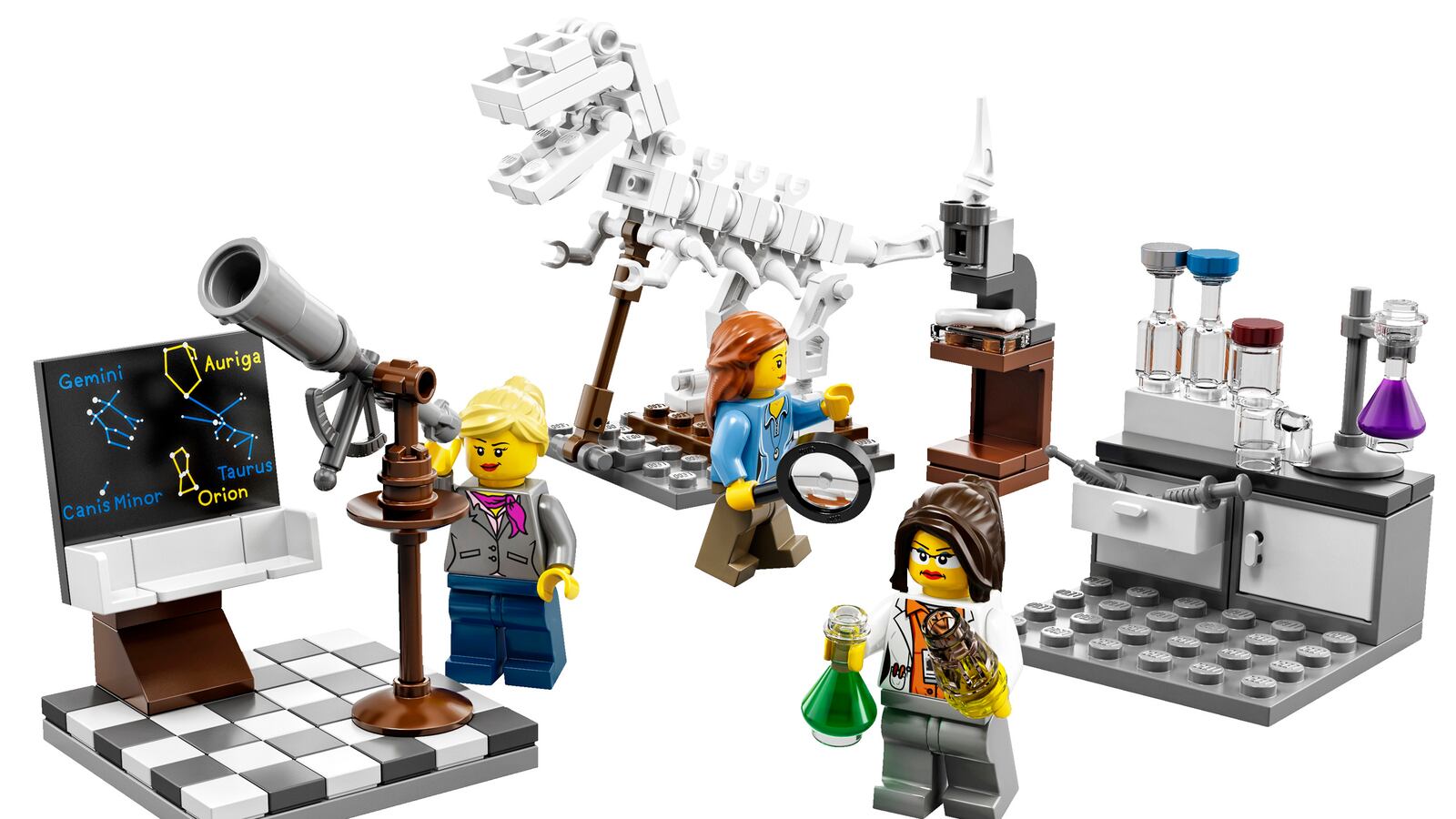In February of this year, 7-year-old Charlotte Benjamin wrote a stern letter to LEGO describing the gender disparities she observed on their product packaging. “All the girls did was sit at home, go to the beach and shop, and they had no jobs,” she wrote, “but the boys went on adventures, worked, saved people, and had jobs, even swam with sharks.” In short, Charlotte noticed that all of the female LEGO figurines seem to live on Miami Beach and all the male LEGO figurines seem to be Australian park rangers. Her request was simple: “I want you to make more LEGO girl people and let them go on adventures and have fun, OK!?!”
Six months later, Ms. Benjamin has proved that a little girl’s pen is truly mightier than a LEGO pirate cutlass. Her viral letter has been at the center of a groundswell of public opinion that finally spurred LEGO to release its new Research Institute playset, which includes a paleontologist, an astronomer, and a chemist, all of whom are women. The playset, as ThinkProgress notes, will undoubtedly help young girls dream of future careers in traditionally male-dominated STEM fields. And, if the paleontologist, astronomer, and chemist join forces, they might also fulfill my own lost girlhood dream of building a real-life Jurassic Park on the moon.
LEGO’s new playset is making headlines for its steps toward addressing the company’s ingrained sexism and, if the reported 30-day wait for an order is any indication, the toys are also flying off of store shelves. But why did it take this long for LEGO to create a set of female scientists in the first place? While the LEGO girls were busy sunbathing, Barbie has been out collecting male-dominated occupations to add to her already voluminous resume. She’s been a doctor, a firefighter, an Air Force pilot, even the President of the United States. She’s been a paleontologist, incidentally, since 1997.
Toys aside, over 45 percent of non-LEGO (i.e. human) chemists and material scientists are women, so creating a lady LEGO chemist is not exactly a leap of faith. So why did consumers have to wait until 2014 for this playset? And what is it about LEGOs that has made them particularly resistant to social change?
One easy answer lies in the patrilineal history of LEGO itself. The LEGO Group is a historically Danish company that grew from a carpentry shop in the 1930s into the massive toy manufacturer and multimedia enterprise that it is today. According to the company’s website, “[LEGO] has passed from father to son and is now owned by Kjeld Kirk Kristiansen, a grandchild of the founder.” This is a company founded by men, passed down through men, and dominated by men. Looking at LEGO’s website is like watching an episode of Mad Men: their Board of Directors has a single female member and their higher-level management team appears to include only two women. LEGO has always been in male hands and it likely will be until one of the Kristiansen sons rejects the family name and takes a job at Playmobil.
From its roots in carpentry—an occupation that is only 1.5 percent female, according to Census 2000—to its focus on robotics in the 1990s, LEGO has always stayed true to the boys that its founders once were. It should be no surprise that a company with deep roots in a traditionally male-dominated field might have trouble representing women in male-dominated fields. How can we expect LEGO to make a female figurine with a career when they can barely promote a flesh-and-blood woman to the top tiers of their management structure?
It took the company until 2011 to target a female demographic with a special line called “Lego Friends,” and even then they were rightly accused by a prominent Change.org petition of pink-washing the toys, of catering to traditionally feminine interests in an overbearing and condescending way. It was the LEGO Friends line, after all, that prompted young Charlotte to pen the most adorable angry letter in consumer history.
And while Barbie is no feminist paragon, her development has definitely benefited from a woman’s touch in ways that should put LEGO to shame. According to Barbie’s official history, Barbie was conceived by Ruth Handler in 1959 when she saw her daughter using small paper dolls as a vehicle for “imagining roles as college students, cheerleaders, and adults with careers.” Handler simply decided to replace her daughter’s makeshift paper dolls with a fully-realized, three-dimensional doll that could act out her fantasies.
The LEGO Group, on the other hand, never stopped to consider the sort of imaginative and aspirational role-play that its figurines could facilitate for young girls. Instead, according to a 2011 Business Week feature, it doubled down on the male market while repeatedly failing to appeal to girls. Somewhere at its core, beneath its worldwide growth and its quadrupling revenue stream, the LEGO Group is still just grandpa's carpentry shop, struggling to understand the fact that girls exist. With missteps like the LEGO Friends line, the company exhibits the same awkwardness as a puppy that has grown up too fast and doesn’t understand its own size.
But there are also deeper philosophical issues at play in LEGO’s blockheaded approach to diversifying its customer base. LEGO has succeeded in convincing itself and its public that its brand is endearingly and refreshingly neutral. In fact, even critics of LEGO, like Helen Czerski at The Guardian, find its attempt to cater to female customers particularly frustrating because “LEGO is the perfect gender-neutral toy.” The commenters on the Change.org petition of the LEGO Friends line, too, express nostalgia for a simpler time when children could “build whatever they want” out of “giant buckets of generic LEGOs.”
This idea that LEGOs are generic, neutral, valueless toys, however, is a deliberate branding strategy that LEGO works hard to maintain. The company intentionally markets their figurines as everymen, seamless vehicles for identification that allow children to imagine themselves in a variety of extraordinary occupations and situations. In a 2010 interview with Gizmodo, for example, LEGO’s brand relations manager Michael McNally gave the following rationale for the skin color of LEGO figurines: “The yellow-headed minifigure was a conscious choice. Because of their ethnically neutral skin color, LEGO people can be any people—in any story, at any time.” According to LEGO, anyone should be able to see themselves in their figurines.
But the irony of a white man in Connecticut setting himself up as the authority on “ethnically neutral skin color” should not go unnoticed. The spectrum of human skin color is vast and LEGO’s ostensibly neutral choice is firmly on the lighter end of that spectrum. In her classic essay on white privilege, Peggy McIntosh observes that supposedly universal products like bandages are designed to mirror the skin of light-skinned people. LEGOs, historically, have been no exception to this trend. According to the same Gizmodo interview, LEGO did not include black figurines until the release of an NBA series in 2003 and a Star Wars series the following year. With this new development, LEGO tacitly undermined its own claims to neutrality. Someone in their ranks was forced to admit that Samuel L. Jackson just didn’t look right with a yellow head.
LEGO figurines reflect the norms of a dominant culture under the guise of neutrality. The company’s history with race typifies the way in which a claim to neutrality is often used as a smokescreen for a deliberate choice to exclude. It’s not a coincidence that bandages are beige, it’s not a coincidence that the default gender-neutral pronoun in English used to be “he,” and it’s not a coincidence that the LEGO Wedding Favor set includes a traditional bride and a groom. LEGOs have always been inscribed with particular normative values; they’ve never been “generic,” nor have they been “gender-neutral.” LEGO people didn’t populate the planet through sexual reproduction, after all—they were made by real people (real white, male people) who made decisions about how these plastic people should appear and what they should do. And LEGO has certainly taken their time recanting those exclusionary decisions.
LEGO’s new female scientist playset will do important cultural work for the lucky girls who get to play with it. As someone who grew up during the simpler “giant bucket” days, I’m certainly envious; those buckets of “generic” LEGOs always ended up smelling like vomit anyway. But loudly praising LEGO for producing a playset of female scientists in the year 2014 feels premature. It’s taken them 80 years to complete Step One. I’ll hold my applause until they’ve assembled a diverse company and an equally diverse line of products.






